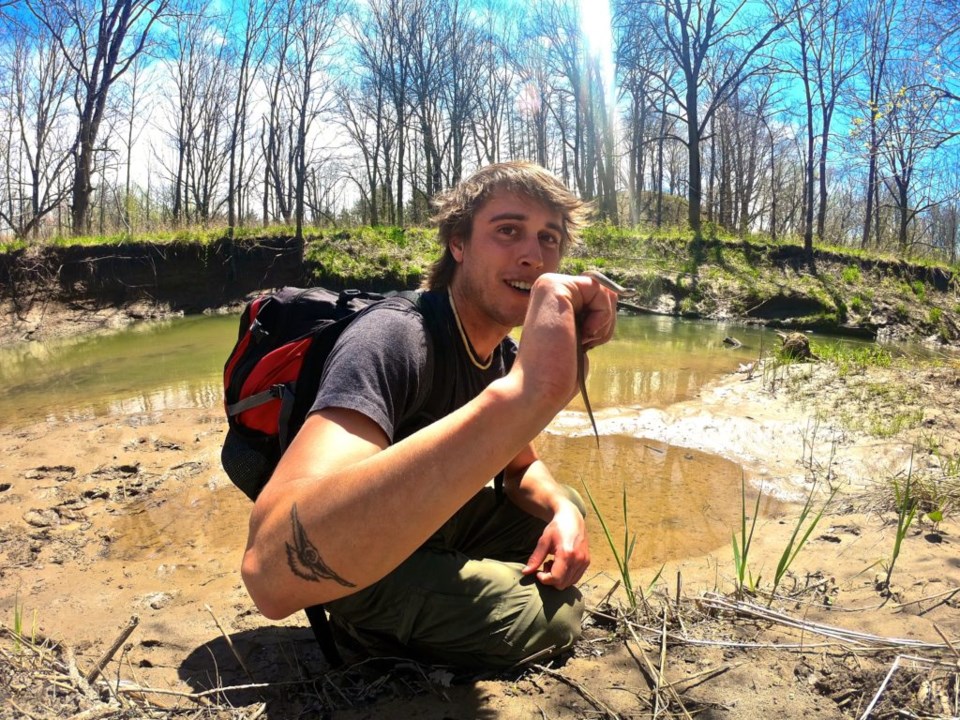
My shoes are caked in mud, sitting by the vent, again. The little pieces of the gunk are breaking free from the tread, and are now polka-dotting the tile floor.
It has been just another day for me since I’ve been back from Australia this March — between working at Heartland Forest on weekdays and running my hiking tours on weekends, I’m outside seven days a week. Those who know me can guess if I have a day off, that’s where I’ll be as well.
I haven’t missed a beat this spring, so here is a report “from the field” of what’s going on out in the woods.
At the start of May, we are just past the halfway point for new plant material to make itself known. As the season is changing while you read this, an order of events is set to unfold. There is an expected sequence of species to pop up following winter’s icy grip. The remarkable part is that although each spring is a little bit different in Niagara-on-the-Lake, there is still a code that the plants and animals adhere to consistently.
Small herbaceous plants, like wild leek, will give way to trout lilies, and that means the trilliums and blue cohosh aren’t far behind.
Mayapple pierces up through the mud like a shrivelled umbrella, and then spreads like a wavy miniature palm tree a week later. If you pay close attention, there is a whole other code to follow in terms of when the berries appear, or the flowers open up. It’s an unseeable driving force of natural cues that wakes up these plants, one by one.
The tiny western chorus frog is one we have here in NOTL’s wetlands. Its call resembles a fingernail running through a comb, but reverberates with a high pitch that can dominate in wet farm fields and swampy forests at this time of year. At the same time, or shortly after, the spring peeper begins calling.
Leopard frogs and wood frogs are next in line — one sounds like an old man laughing at his own joke, the other like a quacking duck. In a couple of weeks, the green frog (truly, that’s what it is called) will start filling NOTL’s irrigation ditches with loud bellowing noises in the night. It’s the sign summer is around the corner.
I’ve always been fascinated with these events in nature, and how they transpire right before our eyes at this time of year without failure in sequence.
We might wonder, why don’t all of these plants, frogs, and insects just explode out of the ground at the same time on the first nice day of the year? To answer that, we need to look at our human world.
Humankind is forthright and culturally accepting of our competitive nature. We can’t forget the subtle competitions that happen in nature every day, and how some forms of competition are just more low-key than others.
For the plants and frogs to obtain adequate water, sun, nutrients, shelter — whatever it may be — could you imagine what would happen if every living thing came out at the same time and tried to feed, breed, and plant a seed? The ecosystem wouldn’t be able to handle it, and there’d be way too much competition for the necessities. It’s almost as if nature, like a teacher, has assembled all the kids in line, and said, “wait your turn.”
Nature can be a teacher to us in so many ways, if we listen to it. It’s also about listening to the science. Spring isn’t over yet, but as I challenged you earlier, keep an eye and ear out for spring’s fleeting magic before it’s gone.
And then, hello mosquitoes.
Cutline: Owen Bjorgan shows off a Dekay’s Brownsnake he caught this weekend. Like other animals and plants, there is a phase of spring when he expects to see more of them out. This harmless snake lives in NOTL, and enjoys eating slugs and insects. (Photo supplied)